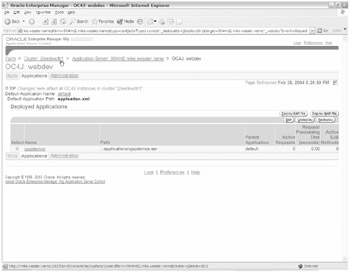Deploying Clustered Applications
| | ||
| | ||
| | ||
In Chapter 15 we discussed how the DCM process manages configuration changes and synchronization between the mid- tier instance and the infrastructure repository. When working with clustered instances, DCM makes sure any changes to one member of the cluster are propagated to all members of the cluster and infrastructure. Even if a clustered member is down when the change is initially made, it will receive the updates through DCM when it's restarted.
When 904mt1 was deployed first to the cluster j2eedevcltr1 , its configuration settings and applications were made the default for the cluster. When the new 904mt2 instance was created it didn't have a webdev OC4J instance nor did it have the ojspdemos demo application deployed to it. However, as you can see in Figure 21-32, these applications have been inherited from the cluster and created within 904mt2 .

Figure 21-32: Inherited webdev OC4J instance and ojspdemos application in 904mt2
Deploying applications to any member of a cluster is the same as deploying to a standalone instance. The biggest change is that deploying to any clustered instance will result in the application being deployed to all instances by DCM. The steps for clustered deployments are as follows :
-
Deploy to the individual instance as normal.
-
If the initial deployment fails for any reason, the deployment doesn't take place and isn't propagated to the infrastructure repository or to any cluster member.
-
If the deployment to the individual clustered instance is successful, DCM propagates the changes to the infrastructure repository.
-
DCM automatically updates the configuration of the other clustered members so that they have the new application and any configuration changes.
-
If any member of the cluster isn't currently available, DCM will update it with the new application and configuration when it does become available.
-
If the new deployment to any other cluster member fails after it has been initially deployed successfully in step 1, the new changes and application remain intact for all other members of the cluster and aren't rolled back.
Applications can be deployed to cluster members either by the ASC utility or from the command line. Application deployments and the tools involved are covered in greater detail in Chapters 17 and 18.
| | ||
| | ||
| | ||
EAN: 2147483647
Pages: 150
- Structures, Processes and Relational Mechanisms for IT Governance
- An Emerging Strategy for E-Business IT Governance
- A View on Knowledge Management: Utilizing a Balanced Scorecard Methodology for Analyzing Knowledge Metrics
- Technical Issues Related to IT Governance Tactics: Product Metrics, Measurements and Process Control
- Managing IT Functions